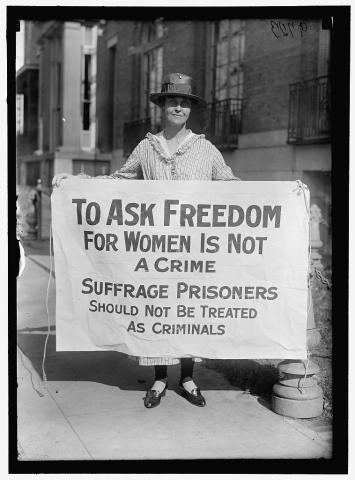Woman Suffrage: A Tale of Two Centuries
Every month seems to have its major national holiday except August. Yet for American women, August holds one of the most important dates, August 26, 1920. This date brought full suffrage or the right to vote for women in America.
About a week before on August 18, 1920, freshman Tennessee State Representative Harry T. Burns had read a letter from his mother that encouraged him to help Carrie Catt put the “rat in ratification”. The letter referred to a popular cartoon at the time which showed an old woman chasing a rat with a broom. Burns propelled Tennessee to the national spotlight by casting the tie-breaking vote that ratified the Nineteenth Amendment to the Constitution. Called the 1878 Susan B Anthony Amendment, it states:
Section 1: The right of citizens of the United States to vote shall not be denied or abridged by the United States or by any State on account of sex.
Section 2: Congress shall have the power to enforce this article by appropriate legislation.
But the road to woman suffrage actually began nearly one hundred years earlier in a small New York town called Seneca Falls, where some 300 women assembled to pass the Declaration of Sentiments which called for equal rights for women. As early as 1828, Frances Wright, a Scotswoman, publicly announced her support for women's rights, abolition of slavery, sexual emancipation, and mental independence to a rather significant Tennessee audience.
From Seneca Falls the road went west to Wyoming to make the fight for woman suffrage a movement from west to east with many of the original 13 states being the last to accept woman suffrage. One key player in the Wyoming movement was Esther Morris. Esther had been born Esther McQuigg in 1820 in New York. When her mother died, eleven year old Esther managed the raising of her younger brothers and the household chores. At nineteen she became a dressmaker and soon opened a hat shop in Oswego, New York. She began attending abolitionists meetings at her local Baptist church, the first antislavery church established in the country. When she was 28, she married Artemus Slack and had a son Archy. The accidental death of Artemus spurred her decision to move to Illinois and live on land that Slack owned.
However, in Illinois, Esther was faced with discrimination and the loss of her inheritance based purely on her being female. Undeterred, Esther opened another hat shop to support her son and herself. Soon she married a Polish immigrant named John Morris. In 1851, she birthed twin boys, Edward and Robert. Esther witnessed the Civil War and saw her son Archy fight with the North to end slavery. Her husband John had never been very successful in Illinois, so he and Archy followed the discovery of gold and moved to the Wyoming Territory in 1868. Esther and the twins followed in 1869.
At fifty-five years old, Esther Morris moved to South Pass City, a rowdy gold rush town. Archy purchased a printing press to begin a newspaper. John ran the saloon. Esther opened a hat shop. Soon Esther became the town nurse and midwife. A call for all males who were at least 21 to vote in the first territorial elections caused her to open her home for a meet the candidates ”tea”. When everyone was assembled, Esther asked if the candidates would support a bill to give women the right to vote. Colonel William Bright agreed and Herman Nickerson, the other candidate also gave his support. Esther Morris wrote letters and visited with families to convince the men to vote for the bill. In 1869, Wyoming gave suffrage to women.
Esther Morris continued her fight for national suffrage. She attended the 1895 National Suffrage Convention. At home in Wyoming, Esther became a Justice of the Peace. When her son Archy, the Court Clerk, swore her in, Esther became the first woman in the United States to hold public office and the first female judge. Today statues of Esther Morris stand in the Wyoming State Capitol and in Congress's Statuary Hall in Washington, DC as a testament to her fortitude and dedication to woman suffrage.
A children's book written by Linda Arms White and titled I Could Do That: Esther Morris Gets Women the Vote is an educational and entertaining approach to the women's movement.
- Log in to post comments
